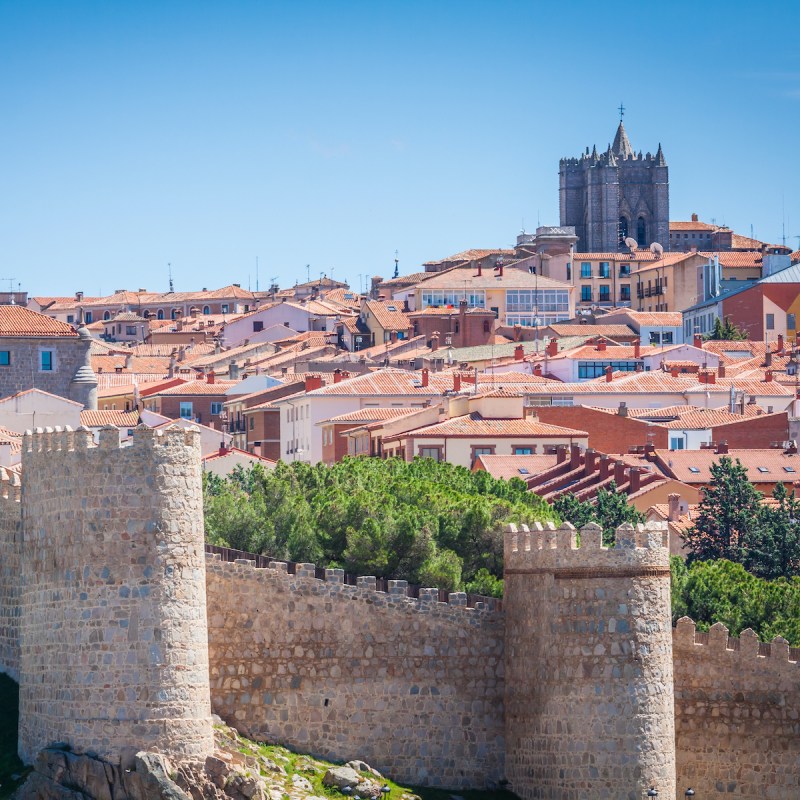
Avila, located in the southern part of Castilla-Leon and approximately 74 miles northwest of Madrid, is often dubbed the “City of Saints and Stones.” Founded in the 11th century to defend Spain from the Moors, Avila is a UNESCO World Heritage Site, mostly because it is one of only a few medieval cities in the world that is totally enclosed in a nearly intact city wall. The city is located on the river Adaja, but on a plateau 1,132 feet above sea level. I came to Avila by train from Madrid and could already see the massive walls, punctuated by 88 semi-circular towers from a distance. An eye-catching sight that also fascinated Italian painter Guido Caprotti over 100 years ago. He arrived in the middle of a snowstorm but was so taken with the atmosphere and beauty of Avila, that he never left.
Videos by TravelAwaits
Avila is the birthplace of one of the most revered Catholic saints, Saint Teresa. Churches and monasteries connected to her abound in Avila, as do sculptures and paintings. Everything in Avila is named after her: bars, restaurants, and even a driving school. Another religious figure is the Grand Inquisitor of Spain, Tomas de Torquemada (1420–1498), who died in the monastery of St. Tomas Aquinas in Avila.
The lighter side to Avila is the famous sweet cookies, called yemas, that are made and sold by the nuns of the monastery of Santa Teresa de Jesus.

1. The Wall Of Avila
The Wall of Avila is a fortification built between the 11th and 14th centuries. It is the most complete city wall in all of Spain. The average height of the wall is 40 feet and it is interspersed with 88 semi-circular towers. There are nine gates, two of which, Gate of St. Vincent and Gate of the Fortress, are flanked by twin towers 66 feet high. The circumference of the wall measures 1.6 miles, half of which can be walked.
Avila’s cathedral is integrated into the wall, which gives you a unique, close-up view of details while walking the wall that you could never get from the ground. In addition, you can look down into courtyards and other private buildings, some with secret gardens and sculptures not accessible from ground level.
You can walk the entire wall at ground level, but going up is much more interesting. There are several access stairs near the towers, the best at the upper end of the cathedral. For opening times and tickets visit this link. Signs indicating the access stairs to the wall are in many places of the city.
Pro Tip: Wear comfortable walking shoes. The walkway is not particularly uneven but it’s long and you have to turn around at the end. The streets and pavements are a different matter as they are all cobblestone.

2. Cathedral Of The Savior
Built in the 12th century, this was the first Gothic cathedral in Spain. The apse is one of the turrets of the city walls. This is a true cathedral/fortress with incorporated sentry walks, The Gothic style is rather stern, but the sacristy is remarkable because it has a star-shaped cupola with gold inlays.

3. Basilica San Vicente
This 11th-century basilica is located outside the city walls and took two centuries to complete. It has built in a mixture of Romanesque and Gothic styles which makes it interesting to visit.

4. Church And Convent Of Saint Teresa
She was born in 1515 with the full name of Teresa Cepeda y Ahumada. She was religiously inclined from an early age and joined the Carmelite Order at age 19. She felt that the order had become somewhat lax and spent much of her life reforming Carmelite monasteries and founding new ones, traveling all over Spain. This church, built in the purest Carmelite Baroque style, is actually her birth house. The surprise is the crypt underneath which contains a marble statue of the saint. She is often depicted with an arrow through her heart. She claimed an angel threw an arrow at her that left her “on fire with a deep love for God.” Some 300 years after her death in 1582, her body was exhumed and it was discovered that she actually had a hole in her heart. The church was opened in 1636. It’s located in Plaza de la Santa and the Baroque façade can clearly be seen through the opening in Gate of the Fortress.

5. Monastery Of The Incarnation
The monastery, which today is an active convent and contains the Museum of St. Teresa, is located just outside the city walls. St. Teresa lived and worked here for 30 years and you can visit her monastic cell as well as see many of her writings in the museum. A visit here rounds out the Santa Teresa “pilgrimage,” a tour you simply can’t avoid on any visit to Avila.

6. The Sephardic Garden Of Moshe De Leon
During the Middle Ages and before the expulsion of the Jews in Spain, there was a large and thriving Jewish community in Avila. They set up their shops and businesses in the center of town and a walk through the former Jewish quarter reveals several treasures. One is the cemetery, which wasn’t discovered that long ago, and another is the peaceful garden of Moshe de Leon, author of the Book of Splendor. Located opposite the Gate de la Malaventura, the street leads straight into the former Jewish quarter. The garden, apart from lush plants and flowers, contains a monolith covered with some Hebrew verses from the Book of Splendor.
On the right bank of the river Adaja were the tanneries of San Segundo, also run by the Jewish people until their expulsion. Extensive excavations have revealed jars, instruments, and floors documenting the tanning process and the making of leather clothes. They were active from the 14th to the 18th centuries. The interesting site can be seen from the bridge but is not currently visited because of the ongoing restorations.

7. Palacio De Los Superundo
The palace of Los Superunda was built around 1580 in the Renaissance style. It’s located in the center of the historical quarter of Avila and also known as the Palace Caprotti. The name comes from Italian painter Guido Caprotti, who became so enchanted with Avila that he remained in the city for the rest of his life. He was accepted quickly in Avila society and even designated “Adopted Son of Avila” in 1918. Together with his wife, Laura de la Torre, a painter of miniatures, he bought the palace and made it his home and workshop. Visiting the palace reveals a treasure trove. Not only because of the original features and antique furniture but also because of the vast collection of the paintings of Caprotti. Although he worked for commissions, his favorite subjects were landscapes and the people of his time, giving a near-photographic image of what Avila and its population looked like over 100 years ago. Also displayed are his wife’s delightful miniatures. Look for the white flags hanging at the front and you’ll easily find the entrance.
8. Convent Of Santa Maria De Jesus
This 16th century rather plain brick building is an active monastery of the Clarisse nuns. Located on a hill overlooking the impressive panorama of Avila, it’s a bit outside the city. The nuns are famous for the sweets and votive candles that were all made in the monastery. They used to sell their items while hidden behind walls, but times have changed and they are happy to sell their products in the convent’s shop. They even have an online shop.

9. Yemas And Chuleton De Avila
Exploring Avila and looking for all the more or less hidden treasures involves lots of walking, mostly along medieval cobblestone streets. This, in turn, makes it necessary to have a hearty meal and Avila has a few specialties to offer. The most famous is Chuleton de Avila, a huge cut of veal from the acorn-fed black pigs (Negra Iberica) of the region. Bone and fat are left on and the cut, which is often so big it can feed two people, is served barbecued. It comes on a wooden slab rather than a plate accompanied by potatoes and vegetables.
Yemas, which translates into “egg yolk,” are sweet pastries that come in the shape of small orange balls, presented in white confectionary paper and made in honor of Saint Teresa, mostly by the Clarisse nuns. Images of smiling nuns making yemas are displayed in many bakeries in Avila.
